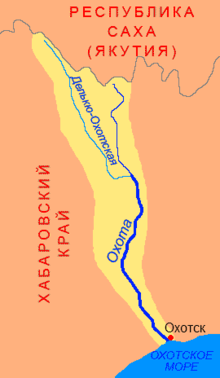Okhota River
| Okhota River | |
|---|---|
 Map of Ohota River Basin | |
| Country | Russia |
| Basin | |
| Main source | Suntar-Khayata Range |
| River mouth | Sea of Okhotsk |
| Basin size | 11,900 square kilometres (4,600 sq mi) |
| Physical characteristics | |
| Length | 393 km (244 mi) |
| Discharge |
|
The Okhota River (Russian: Охота, lit. Hunting, and from a Tungus word meaning "river ") is a river in Khabarovsk Krai, which flows south to the Sea of Okhotsk at the town and port of Okhotsk.
Okhota River is 393 kilometres (244 mi) long, and its drainage basin covers 19,100 square kilometres (7,400 sq mi).[1] It is frozen from early November to May. Snow cover in the valley can last until late June. To the east is the parallel Kukhtui River and then the Kukhtui Range. To the west to the short Urak River and to the north of it, the Yudoma Range. North of its headwaters, on the other side of the Suntar-Khayata Range, another river runs north to join the Indigirka River near Omyakon.
It begins in the Suntar-Khayata Range at about 1,200 metres (3,900 ft) above sea level at the junction of the Left Okhota and Right Okhota rivers. These are about 10 kilometres (6 mi) long and start from an elevation of 1,800 to 2,000 metres (5,900 to 6,600 ft). First a mountain stream, the river later flows along with the Kukhtui River in wide valley between Yudom and Kukhtuy Ranges and joins the Kukhtui River to form the harbor of Okhotsk which is separated from the sea by a sand spit. In 1810 the ice-choked river cut a new mouth through the spit at Novoye Ustye.
The banks of the river in the mostly forested. There is an important salmon run. The lower reaches of the river are navigable for small craft.
Since there are no easy portages to the Okhota, the Russians usually approached Okhotsk from the Urak River or the Ulya River to the west. The only main route that used the Okhota ran from the "corner" of the Yudoma River over the 100-kilometre (62 mi) Okhotsk Portage to the Okhota about 100 kilometres north of its mouth. There was some pasture along the river but not enough to keep many Yakutsk pack-horses over winter. Larch was cut and floated down the river for shipbuilding. Around 1750 there were 37 peasant families and from 1735 a few Yakut cattlemen.
References
James R Gibson, "Feeding the Russian Fur Trade", 1969
Coordinates: 59°19′42″N 143°04′21″E / 59.32833°N 143.07250°E
